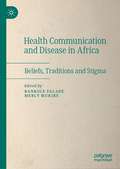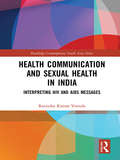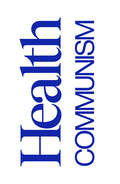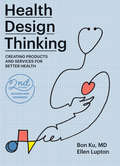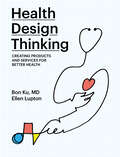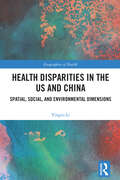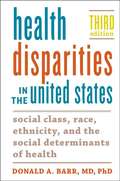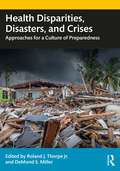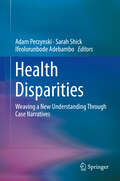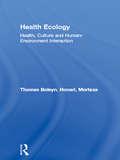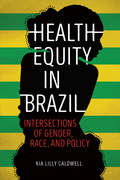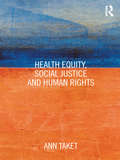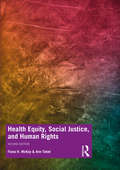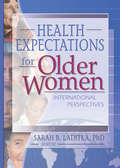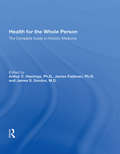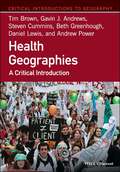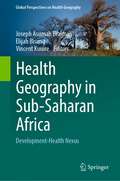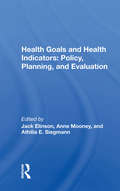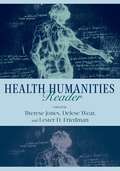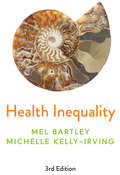- Table View
- List View
Health Communication and Disease in Africa: Beliefs, Traditions and Stigma
by Bankole Falade Mercy MurireThis book is a collection of essays from across Africa which highlight the roles of beliefs and traditions in health behaviour. Chapters address mental health, risk perception, stigma, reproductive health, religion and health. The book also examines conceptual approaches in health communication and community development, both western and indigenous. Specific topics include Alzheimer’s, HIV and stigma; perception of risk from obesity, HIV prevention and preeclampsia; doctor-patient relationship and health beliefs of birth attendants; culture and mental health access and social media effects on mental health; the complementary use of contemporary and indigenous communication strategies and the accommodation of science by religious leaders during the COVID 19 pandemic. The book, which starts by examining global inequalities in health, proposes an African approach informed by problematisation as theorised by Foucault and Freire, to unpack habits and social problems. It ends by asking the question: “Is science enough” and making a strong case for health enabling environments alongside science communication.
Health Communication and Sexual Health in India: Interpreting HIV and AIDS messages (Routledge Contemporary South Asia Series)
by Ravindra Kumar VemulaOver the past few years, ever since the advent of HIV and AIDS, there has been increasing discussion of the concept of sexual health. This upsurge is especially noticeable not only in the field of health education and promotion but also in academic sources. The recent discourse on sexual health is paralleled by an upsurge in the debate on sexual rights. This book examines the social construction of sexual health in India through an analysis of HIV and AIDS messages. The broad objective of the chapters is to trace the growth and evolution of the concept of sexual health from a health communication perspective and to understand the role of the state in determining its form and structure. The methodology used includes comparative analysis of HIV and AIDS policies, document analysis on HIV and AIDS, poster and short films analysis, in depth and open-ended Interviews and case studies. The book shows that Sexual Health is constructed in various modes in India. The models that are elaborated are the Medical model that constructs HIV scientifically and in terms of a compromised immune system; the Epidemic model that identifies risk behaviours and transmission routes and the Moralistic model. Social constructions of AIDS as plague or punishment against society are advanced by moralists who equate HIV with taboo social and sexual behaviour and the political constructions highlights public health in the face of obstacles to treatment and the delivery of services to people living with HIV. Bringing together current research and discussions on the three areas of policy, practices and theoretical perspectives related to the use and social construction of sexual health through HIV and AIDS communication approaches with specific reference to India, this book will be of interest to academics in the field of health communication, HIV and AIDS, and South Asian Studies.
Health Communism: A Surplus Manifesto
by Beatrice Adler-Bolton Artie VierkantA searing analysis of health and illness under capitalism from hosts of the hit podcast &“Death Panel&” In this fiery, theoretical tour-de-force, Beatrice Adler-Bolton and Artie Vierkant offer an overview of life and death under capitalism and argue for a new global left politics aimed at severing the ties between capital and one of its primary tools: health. Written by co-hosts of the hit &“Death Panel&” podcast and longtime disability justice and healthcare activists Adler-Bolton and Vierkant, Health Communism first examines how capital has instrumentalized health, disability, madness, and illness to create a class seen as &“surplus,&” regarded as a fiscal and social burden. Demarcating the healthy from the surplus, the worker from the &“unfit&” to work, the authors argue, serves not only to undermine solidarity but to mark whole populations for extraction by the industries that have emerged to manage and contain this &“surplus&” population. Health Communism then looks to the grave threat capital poses to global public health, and at the rare movements around the world that have successfully challenged the extractive economy of health. Ultimately, Adler-Bolton and Vierkant argue, we will not succeed in defeating capitalism until we sever health from capital. To do this will require a radical new politics of solidarity that centers the surplus, built on an understanding that we must not base the value of human life on one&’s willingness or ability to be productive within the current political economy. Capital, it turns out, only fears health.
Health Crises and Media Discourses in Sub-Saharan Africa
by Carol Azungi Dralega Angella NapakolThis is an open access book which brings together leading scholars and critical discourses on political, economic, legal, technological, socio-cultural and systemic changes and continuities intersecting media and health crises in Sub-Saharan Africa. The volume extensively discusses COVID-19 but it also covers other epidemics, such as malaria, HIV/AIDS as well as “silent” health crises such as mental health---simmering across the subcontinent. The chapters fill knowledge gaps, highlight innovations, unpack the complexities surrounding the media ecosystem in times of health crises. They explore, among other issues, the politics of public health communication; infodemics; existential threats to media viability; draconian legislations; threats to journalists/journalism; COVID-related entrepreneurship, marginalization, and more.This is a timely resource for academics, advocacy groups, media practitioners and policy makers working on crises and media reporting, not just in Africa but anywhere in the global South.
Health Design Thinking, second edition: Creating Products and Services for Better Health
by Ellen Lupton Bon KuA practice-based guide to applying the principles of human-centered design to real-world health challenges; updated and expanded with post–COVID-19 innovations. This book offers a practice-based guide to applying the principles of human-centered design to real-world health challenges that range from drug packaging to breast cancer detection. Written by pioneers in the field—Bon Ku, a physician leader in innovative health design, and Ellen Lupton, an award-winning graphic designer—the book outlines the fundamentals of design thinking and highlights important products, prototypes, and research in health design. This revised and expanded edition describes innovations developed in response to the COVID-19 crisis, including an intensive care unit in a shipping container, a rolling cart with intubation equipment, and a mask brace that gives a surgical mask a tighter seal. The book explores the special overlap of health care and the creative process, describing the development of such products and services as a credit card–sized device that allows patients to generate their own electrocardiograms; a mask designed to be worn with a hijab; improved emergency room signage; and a map of racial disparities and COVID-19. It will be an essential volume for health care providers, educators, patients, and designers who seek to create better experiences and improved health outcomes for individuals and communities.
Health Design Thinking: Creating Products and Services for Better Health
by Ellen Lupton Bon KuApplying the principles of human-centered design to real-world health care challenges, from drug packaging to early detection of breast cancer.This book makes a case for applying the principles of design thinking to real-world health care challenges. As health care systems around the globe struggle to expand access, improve outcomes, and control costs, Health Design Thinking offers a human-centered approach for designing health care products and services, with examples and case studies that range from drug packaging and exam rooms to internet-connected devices for early detection of breast cancer. Written by leaders in the field—Bon Ku, a physician and founder of the innovative Health Design Lab at Sidney Kimmel Medical College, and Ellen Lupton, an award-winning graphic designer and curator at Cooper Hewitt Smithsonian Design Museum—the book outlines the fundamentals of design thinking and highlights important products, prototypes, and research in health design.Health design thinking uses play and experimentation rather than a rigid methodology. It draws on interviews, observations, diagrams, storytelling, physical models, and role playing; design teams focus not on technology but on problems faced by patients and clinicians. The book's diverse case studies show health design thinking in action. These include the development of PillPack, which frames prescription drug delivery in terms of user experience design; a credit card–size device that allows patients to generate their own electrocardiograms; and improved emergency room signage. Drawings, photographs, storyboards, and other visualizations accompany the case studies.Copublished with Cooper Hewitt, Smithsonian Design Museum
Health Disparities in the US and China: Spatial, Social, and Environmental Dimensions (Geographies of Health Series)
by Yingru LiThis book provides a comprehensive insight into health disparities in both the United States and China. It offers valuable perspectives on public health and policy through an examination of the spatial, social, and environmental dimensions of health disparities.Through comparative analysis of two distinct healthcare systems, economic conditions, and cultural contexts, the book offers a thorough assessment of how policies and social structures influence public health outcomes. It examines factors such as socioeconomic status, social capital, community, social and physical environments, healthcare systems, and health policies. The book adopts an interdisciplinary approach, drawing on key theoretical frameworks such as socio-ecological model, social determinants of health (SDOH), and social capital theory. It integrates geospatial, statistical, and survey analyses and includes a series of case studies to explore health disparities.This book will be of interest to students and researchers in medical geography, medical sociology, and public health, as well as professionals and policy makers who address spatial, social, and environmental disparities.
Health Disparities in the United States: Social Class, Race, Ethnicity, and the Social Determinants of Health
by Donald A. BarrAn essential text for courses in public health, health policy, and sociology, this compelling book is a vital teaching tool and a comprehensive reference for social science and medical professionals.
Health Disparities in the United States: Social Class, Race, Ethnicity, and the Social Determinants of Health
by Donald A. BarrChallenging students to think critically about the complex web of social forces that leads to health disparities in the United States.The health care system in the United States has been called the best in the world. Yet wide disparities persist between social groups, and many Americans suffer from poorer health than people in other developed countries. In this revised edition of Health Disparities in the United States, Donald A. Barr provides extensive new data about the ways low socioeconomic status, race, and ethnicity interact to create and perpetuate these health disparities. Examining the significance of this gulf for the medical community and society at large, Barr offers potential policy- and physician-based solutions for reducing health inequity in the long term.This thoroughly updated edition focuses on a new challenge the United States last experienced more than half a century ago: successive years of declining life expectancy. Barr addresses the causes of this decline, including what are commonly referred to as "deaths of despair"—from opiate overdose or suicide. Exploring the growing role geography plays in health disparities, Barr asks why people living in rural areas suffer the greatest increases in these deaths. He also analyzes recent changes under the Affordable Care Act and considers the literature on how race and ethnicity affect the way health care providers evaluate and treat patients.As both a physician and a sociologist, Barr is uniquely positioned to offer rigorous medical explanations alongside sociological analysis. An essential text for courses in public health, health policy, and sociology, this compelling book is a vital teaching tool and a comprehensive reference for social science and medical professionals.
Health Disparities, Disasters, and Crises: Approaches for a Culture of Preparedness
by Roland J. Thorpe Jr. DeMond S. MillerHealth Disparities, Disasters, and Crises: Approaches for a Culture of Preparedness presents a roadmap to help guide the actions needed to address health disparities introduced as part of the pre-planning, planning, and mitigation phases of natural and technological disasters. With contributions from 30 scholars in disaster management in public health, this text explores how the intersectionality of health disparities of different socioeconomic and racial/ethnic groups and how social determinants help shape exposure, and vulnerability to pandemic disasters and crises. Supported by examples from across the world, chapters are supplemented with case studies of best practices, graphs, and tables. Each of the seven parts address different topics, including how disasters affect the poor, medically underserved, and racial/ethnic groups, the impact of health disparities, and the growing link between global health, disaster planning/mitigation, and global security. Written for the benefit of undergraduate and graduate students, working professionals, and academics in the US and abroad, Health Disparities, Disasters, and Crises: Approaches for a Culture of Preparedness provides the best overall understanding of professional disaster management and safety for all citizens. It is also an ideal text for graduate and undergraduate courses in public health, public policy, medicine and nursing, healthcare administration, emergency management, emergency preparedness, homeland security, epidemiology, sociology, and medical sociology.
Health Disparities: Weaving a New Understanding Through Case Narratives
by Adam Perzynski Sarah Shick Ifeolorunbode AdebamboThis uniquely accessible volume challenges professionals to understand—and help correct—health disparities, both at the patient level and in their larger social contexts. Dedicated to eradicating this ongoing injustice, contributors focus on marginalized populations, the role of healthcare systems in perpetuating inequities, the need for deeper engagement and listening by professionals, and the need for advocacy within professional education and the political/policy arena. The compelling case narratives at the core of the book illustrate the interrelated biopsychosocial components of patients’ health problems and the gradations of learning needed for practitioners to address them effectively. The book’s tools for developing a health disparities curriculum include a selection of workshop exercises, facilitator resources, and a brief guide to writing effective case narratives. A sampling of the narratives: “Finding the Person in Patient-Centered Health Care” (race/ethnicity/culture). “The Annual Big Girl / Big Boy Exchange” (gender). “Just Give Me Narcan and Let Me Go” (poverty/addiction). “Everyone Called Him Crazy” (immigration). “Adrift in the System” (disability). “Aging out of Pediatrics” (mental illness and stigma). “Time to Leave” (LGBT) A work of profound compassion, Health Disparities will be of considerable interest to researchers and practitioners interested in public health, population health, health disparities, and related fields such as sociology, social work, and narrative medicine. Its wealth of educational features also makes it a quality training text. "I was impressed when I read Health Disparities: Weaving a New Understanding through Case Narratives. As a patient who has experienced unpleasant situations in health care, I was moved to see that it was emotional and personal for the writers. The book confirms for me that the time is now for change to take place in our health care systems. I see this book as a light that can shine bright in the darkest places of health care. The editors have assembled a powerful book that provides all health professionals with specific steps they can take towards addressing and then eventually eliminating health disparities. A few steps that I really connected with were improving critical awareness, delivering quality care, listening and empathizing with patients and families, and advocating for changes. I recommend that anyone interested in working to improve health care obtain a copy of this book—it’s filled with useful information that every medical professional should know. The book reminds me of a quote by Wayne Dyer, 'When you change the way you look at things, the things you look at change.'" -Delores Collins, Founder and Executive Director, A Vision of Change Incorporated, Certified Community Health Worker. Founder of The Greater Cleveland Community Health Workers Association.
Health Ecology: Health, Culture and Human-Environment Interaction
by Morteza Honari Thomas BoleynThis ground-breaking study offers new challenges to those teaching, studying or developing strategies and policies in health and the environment.Bringing together a variety of approaches from different perspectives and different locations, the contributors examine the various dimensions of health ecology in a human ecology framework, examining how local, regional and global factors impinge upon the health and environment of individuals, communities and the globe.
Health Economics: An International Perspective
by Samantha Smith Charles Normand Barbara McPake Anne NolanHealth Economics: An International Perspective is the only textbook to provide a truly international, comparative treatment of health economics. Offering an analysis of health systems across borders, the fourth edition of this key text has been updated and revised to take account of changes in a host of countries. This edition features an expanded introduction, providing better grounding for many of the examples that come in subsequent chapters and making it easier for non-health care experts to see the links between the theory, the examples and the health care system components. It also boasts a restructured format, dividing the book into two broad sections: the first focuses on ideas and principles, along with evidence on their applications in the health sector, whereas the second focuses on introducing core tools and techniques used in applied health economics research. Further updates to this edition include: two new chapters on applied econometrics; a new chapter on equity, focusing on equity in access to health care, paying particular attention to how access and need for health care are defined and measured in applied research; a new chapter on emerging issues for health systems that are emanating from a series of global transitions both within (e.g. demographic change, epidemiological change, the global resolution on universal health coverage) and without the health sector (e.g. economic transitions). Throughout the text, examples and illustrations are taken from a wide range of settings and world regions, providing a unique overview of the performance of different health systems.
Health Equity in Brazil: Intersections of Gender, Race, and Policy
by Kia Lilly CaldwellBrazil's leadership role in the fight against HIV has brought its public health system widespread praise. But the nation still faces serious health challenges and inequities. Though home to the world's second largest African-descendant population, Brazil failed to address many of its public health issues that disproportionately impact Afro-Brazilian women and men. Kia Lilly Caldwell draws on twenty years of engagement with activists, issues, and policy initiatives to document how the country's feminist health movement and black women's movement have fought for much-needed changes in women's health. Merging ethnography with a historical analysis of policies and programs, Caldwell offers a close examination of institutional and structural factors that have impacted the quest for gender and racial health equity in Brazil. As she shows, activists have played an essential role in policy development in areas ranging from maternal mortality to female sterilization. Caldwell's insightful portrait of the public health system also details how its weaknesses contribute to ongoing failures and challenges while also imperiling the advances that have been made.
Health Equity, Social Justice and Human Rights
by Ann TaketImportant links between health and human rights are increasingly recognised and human rights can be viewed as one of the social determinants of health. Furthermore, a human rights framework provides an excellent foundation for advocacy on health inequalities, a value-based alternative to views of health as a commodity, and the opportunity to move away from public health action being based on charity. This text demystifies systems set up for the protection and promotion of human rights globally, regionally and nationally. It explores the use and usefulness of rights-based approaches as an important part of the tool-box available to health and welfare professionals and community members working in a variety of settings to improve health and reduce health inequities. Global in its scope, Health Equity, Social Justice and Human Rights presents examples from all regions of the world to illustrate the successful use of human rights approaches in fields such as HIV/AIDS, improving accessibility to essential drugs, reproductive health, women’s health, and improving the health of marginalised and disadvantaged groups. Understanding human rights and their interrelationships with health and health equity is essential for public health and health promotion practitioners, as well as being important for a wide range of other health and social welfare professionals. This text is valuable reading for students, practitioners and researchers concerned with combating health inequalities and promoting social justice.
Health Equity, Social Justice and Human Rights
by Ann Taket Fiona H McKayThis text demystifies systems set up for the protection and promotion of human rights globally, regionally and nationally. It explores the use and usefulness of rights-based approaches as an important part of the toolbox available to health and welfare professionals and community members working in a variety of settings to improve health and reduce health inequities. Global in its scope, Health Equity, Social Justice and Human Rights presents examples from all over the world to illustrate the successful use of human rights approaches in fields such as HIV/AIDS, improving access to essential drugs, reproductive health, women’s health, and improving the health of marginalised and disadvantaged groups. Important links between health and human rights are increasingly recognised, and human rights can be viewed as one of the social determinants of health. A human rights framework provides an excellent foundation for advocacy on health inequalities, a value-based alternative to views of health as a commodity, and the opportunity to move away from public health action being based on charity. Understanding human rights and their interrelationships with health and health equity is essential for public health and health promotion practitioners, as well as being important for a wide range of other health and social welfare professionals. This text is valuable reading for students, practitioners and researchers concerned with combating health inequalities and promoting social justice.
Health Expectations for Older Women: International Perspectives
by Sarah B. LaditkaExplore international trends in health and longevity--with a special focus on older women!This essential book examines the latest research on life expectancy and “active life expectancy”--the number of years that women can expect to live free from major disability--in developed and developing countries around the world. It also explores the policy implications of the contributors’ findings. Here you'll find a global study using data from the World Health Organization, a European study using data from OECD countries, and studies of women in the United Kingdom, Fiji, The Netherlands, Japan, Canada, and the United States.With contributions from demographers, economists, epidemiologists, gerontologists, medical statisticians, policy analysts, physicians, public health directors, and sociologists, International Perspectives on Health Expectancies for Older Women compares mortality and morbidity trends in various populations. In addition to reviewing the current literature on active life expectancy, this informative book looks at: the distribution of total, unimpaired, and impaired life for several groups of older women defined by race, education, and marital history gender differences in health profiles in The Netherlands gender differences in life with and without six major diseases, including both morbid and mortal conditions in the United States how mortality and morbidity patterns differ for Canadian women and men 45 years of age and older, focusing on risk factors and chronic conditions such as low income, low education, abnormal body mass index, lack of physical activity, smoking, cancer, diabetes, and arthritis patterns of healthy life expectancy for older women around the globe a comparison of the development and progression of physical disability in Japanese men and women and more!
Health For The Whole Person: The Complete Guide To Holistic Medicine
by James Fadiman Arthur C. Hastings James S. GordonThis book presents attitudes, information, and tools for a holistic approach to medicine, health, and mental health. In our discussions among ourselves and with the contributing authors we defined three aspects of a holistic approach. First, such an approach involves expanding our focus to include the many personal, familial, social, and environmental factors that promote health, prevent illness, and encourage healing. Second, a holistic approach views the patient as an individual person, not as a symptom-bearing organism. This attitude emphasizes the self-responsibility of the person for his or her health and the importance of mobilizing the person's own health capacities, rather than treating illness only from the outside. Third, the holistic approach tries to make wise use of the many diagnostic, treatment, and health modalities that are available in addition to the standard materia medica- including alternative medical and healing systems as well as psychological techniques and physical modalities. Some of these methods of treatment and health practices are already accepted, others are accepted but not applied in practice, and still others need further research to explore the range of their uses.
Health Geographies: A Critical Introduction (Critical Introductions to Geography)
by Tim Brown Daniel Lewis Andrew Power Gavin J. Andrews Beth Greenhough Steven CumminsHealth Geographies: A Critical Introduction explores health and biomedical topics from a range of critical geographic perspectives. Building on the field’s past engagement with social theory it extends the focus of health geography into new areas of enquiry. Introduces key topics in health geography through clear and engaging examples and case studies drawn from around the world Incorporates multi-disciplinary perspectives and approaches applied in the field of health geography Identifies both health and biomedical issues as a central area of concern for critically oriented health geographers Features material that is alert to questions of global scale and difference, and sensitive to the political and economic as well sociocultural aspects of health Provides extensive pedagogic materials within the text and guidance for further study
Health Geography in Sub-Saharan Africa: Development-Health Nexus (Global Perspectives on Health Geography)
by Joseph Asumah Braimah Elijah Bisung Vincent KuuireThis volume creates a platform to showcase health geography research from countries in sub-Saharan Africa (SSA), and draws on theoretical and methodological innovations to initiate a discussion on the complexities of the issues impacting health in the region. Through theoretically and empirically grounded contributions from a variety of researchers working across SSA, the book addresses a wide range of topics that are usually treated separately when discussing health geography in the region. By bridging the social science and health disciplines, the book introduces new ways of thinking temporally and spatially about these topics in non-geography contexts as well. In 4 sections, the text will broadly appeal to students, researchers, teachers, policy makers, and global health professionals. Section 1 addresses the social determinants of health, including gender, disability, and other inequities and inequalities associated with healthcare access. Section 2 discusses the environmental determinants of health such as food security, water and sanitation, mining, and climate change. Section 3 focuses on current and emerging challenges to health in SSA, including ageing, non-communicable disease, and infectious diseases. Section 4 concludes the text by discussing the need to develop social and environmental intervention policies and strategies to address health challenges in SSA.
Health Goals And Health Indicators: Policy, Planning, And Evaluation
by Jack Elinson Anne Mooney Athilia E. SiegmannThis volume brings together the perspectives and expertise of both medical and social sciences. The major topics include criteria for the determination of health goals, the analysis of health policies, and the indicators of health status that may he used to judge the consequences of health practices and policies. Unmet health care needs, current national health policy and local planning, health data for policy and planning, and future directions in national health policy are also examined. These issues are then considered in light of the readiness of the sociomedical sciences to measure health status. Contributors discuss the behavioral measurement of health status, the measurement of psychological well-being, the assessment of dental health needs, and the possible impact of recently developed sociomedical health indicators on health policy.
Health Humanities Reader
by Mark Vonnegut Audrey Shafer Martha Stoddard Holmes Howard Brody Jeff Nisker Bradley Lewis Rosemarie Tong Ian Williams Sander L. Gilman Rafael Campo Daniel Goldberg Michael Rowe Thomas R. Cole Alice Dreger Joseph N. Straus Jonathan M. Metzl Arthur W. Frank E. Ann Kaplan Rebecca Hester John Lantos Shelley Wall Alan Bleakley Marjorie Levine-Clark Michael Sappol Mark Clark Professor Therese Jones Professor Delese Wear Professor Lester D. Friedman David H. Flood Rhonda L. Soricelli Lisa Keränen Martin F. Norden Professor Lisa I. Iezzoni Felicia Cohn Martha Montello Amy Haddad Rebecca Garden Jack Coulehan Professor Bernice Hausman Gretchen A. Case Allen Peterkin Susan M. Squier Sayantani DasGupta Maren Grainger-Monsen Benjamin Saxton Jerald Winakur Anne Hudson Jones Tod Chambers Raymond C. Barfield Lucy Selman Jeffrey P. Bishop Catherine Belling Paul Root Wolpe Professor Allison B. Kavey Julie M. Aultman Michael Blackie Erin Gentry Lamb Jay BaruchOver the past forty years, the health humanities, previously called the medical humanities, has emerged as one of the most exciting fields for interdisciplinary scholarship, advancing humanistic inquiry into bioethics, human rights, health care, and the uses of technology. It has also helped inspire medical practitioners to engage in deeper reflection about the human elements of their practice.In Health Humanities Reader, editors Therese Jones, Delese Wear, and Lester D. Friedman have assembled fifty-four leading scholars, educators, artists, and clinicians to survey the rich body of work that has already emerged from the field—and to imagine fresh approaches to the health humanities in these original essays. The collection’s contributors reflect the extraordinary diversity of the field, including scholars from the disciplines of disability studies, history, literature, nursing, religion, narrative medicine, philosophy, bioethics, medicine, and the social sciences. With warmth and humor, critical acumen and ethical insight, Health Humanities Reader truly humanizes the field of medicine. Its accessible language and broad scope offers something for everyone from the experienced medical professional to a reader interested in health and illness.
Health Humanities in Application (Sustainable Development Goals Series)
by Katherine M. Robinson Christian RiegelThis book focuses on health humanities in application. The field reflects many intellectual interests and practical applications, serving researchers, educators, students, health care practitioners, and community members wherever health and wellness and the humanities intersect. How we implement health humanities forms the core approach, and perspectives are global, including North America, Africa, Europe, and India. Emphasizing key developments in health humanities, the book’s chapters examine applications, including reproductive health policy and arts‑based research methods, black feminist approaches to health humanities pedagogy, artistic expressions of lived experience of the coronavirus, narratives of repair and re‑articulation and creativity, cultural competency in physician‑patient communication through dance, embodied dance practice as knowing and healing, interdisciplinarity and transdisciplinarity, eye tracking, ableism and disability, rethinking expertise in disability justice, disability and the Global South, coronavirus and Indian politics, visual storytelling in graphic medicine, and medical progress and racism in graphic fiction.
Health Inequalities and People with Intellectual Disabilities
by Eric Emerson Chris HattonPeople with intellectual disabilities die at a younger age and have poorer health than their non-disabled peers. This is largely avoidable and is unjust. This book uses concepts from contemporary public health to provide a comprehensive evidence-based overview of: the nature and extent of the health inequalities experienced by people with intellectual disabilities; why these inequalities occur and persist; and what can and needs to be done to address these inequalities. The authors have a wealth of firsthand experience gained from years of working at the interface between disability research and public health. This experience is collected and shared in this volume, which will be an invaluable resource for practitioners, advocates, policymakers and researchers concerned with health and social care and the wellbeing of disabled people.
Health Inequality: An Introduction to Concepts, Theories and Methods
by Mel Bartley Michelle Kelly-IrvingThe persistence of stark health inequalities in today’s world is painfully clear to see, not least in the effects of the Covid-19 pandemic and falling life expectancy in many parts of the world. How can we advance our understanding of the full extent of health inequality, what drives it, and ways to address it? The third edition of this popular book closely examines the influence of social class, gender, and race/ethnicity (among other issues) on health in the light of broad macro-political contexts. The classic behavioural, psychosocial, and material approaches to health and their embodiment within a life-course perspective are introduced but, importantly, are also re-situated within the growing understanding of the commercial and political determinants of health. Bartley and Kelly-Irving draw on extensive new evidence that shows how the chances for everyone to lead a long and healthy life depend on where power lies to control health-damaging policies and introduce health-promoting ones. Health Inequality will continue to be essential reading for students taking courses in the sociology of health and illness, social policy and welfare, health sciences, public health and epidemiology and all those interested in understanding the consequences of social inequality for health.
